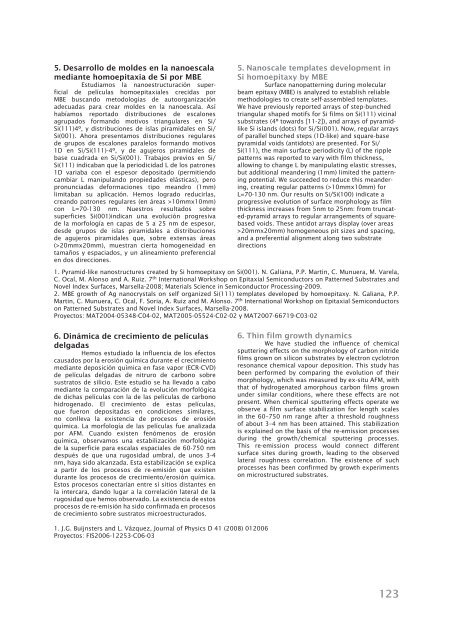Untitled - Materials Science Institute of Madrid - Consejo Superior de ...
Untitled - Materials Science Institute of Madrid - Consejo Superior de ...
Untitled - Materials Science Institute of Madrid - Consejo Superior de ...
You also want an ePaper? Increase the reach of your titles
YUMPU automatically turns print PDFs into web optimized ePapers that Google loves.
5. Desarrollo <strong>de</strong> mol<strong>de</strong>s en la nanoescala<br />
mediante homoepitaxia <strong>de</strong> Si por MBE<br />
Estudiamos la nanoestructuración superficial<br />
<strong>de</strong> películas homoepitaxiales crecidas por<br />
MBE buscando metodologías <strong>de</strong> autoorganización<br />
a<strong>de</strong>cuadas para crear mol<strong>de</strong>s en la nanoescala. Así<br />
habíamos reportado distribuciones <strong>de</strong> escalones<br />
agrupados formando motivos triangulares en Si/<br />
Si(111)4º, y distribuciones <strong>de</strong> islas piramidales en Si/<br />
Si(001). Ahora presentamos distribuciones regulares<br />
<strong>de</strong> grupos <strong>de</strong> escalones paralelos formando motivos<br />
1D en Si/Si(111)-4º, y <strong>de</strong> agujeros piramidales <strong>de</strong><br />
base cuadrada en Si/Si(001). Trabajos previos en Si/<br />
Si(111) indicaban que la periodicidad L <strong>de</strong> los patrones<br />
1D variaba con el espesor <strong>de</strong>positado (permitiendo<br />
cambiar L manipulando propieda<strong>de</strong>s elásticas), pero<br />
pronunciadas <strong>de</strong>formaciones tipo meandro (1mm)<br />
limitaban su aplicación. Hemos logrado reducirlas,<br />
creando patrones regulares (en áreas >10mmx10mm)<br />
con L=70-130 nm. Nuestros resultados sobre<br />
superficies Si(001)indican una evolución progresiva<br />
<strong>de</strong> la morfología en capas <strong>de</strong> 5 a 25 nm <strong>de</strong> espesor,<br />
<strong>de</strong>s<strong>de</strong> grupos <strong>de</strong> islas piramidales a distribuciones<br />
<strong>de</strong> agujeros piramidales que, sobre extensas áreas<br />
(>20mmx20mm), muestran cierta homogeneidad en<br />
tamaños y espaciados, y un alineamiento preferencial<br />
en dos direcciones.<br />
5. Nanoscale templates <strong>de</strong>velopment in<br />
Si homoepitaxy by MBE<br />
Surface nanopatterning during molecular<br />
beam epitaxy (MBE) is analyzed to establish reliable<br />
methodologies to create self-assembled templates.<br />
We have previously reported arrays <strong>of</strong> step-bunched<br />
triangular shaped motifs for Si films on Si(111) vicinal<br />
substrates (4º towards [11-2]), and arrays <strong>of</strong> pyramidlike<br />
Si islands (dots) for Si/Si(001). Now, regular arrays<br />
<strong>of</strong> parallel bunched steps (1D-like) and square-base<br />
pyramidal voids (antidots) are presented. For Si/<br />
Si(111), the main surface periodicity (L) <strong>of</strong> the ripple<br />
patterns was reported to vary with film thickness,<br />
allowing to change L by manipulating elastic stresses,<br />
but additional mean<strong>de</strong>ring (1mm) limited the patterning<br />
potential. We succee<strong>de</strong>d to reduce this mean<strong>de</strong>ring,<br />
creating regular patterns (>10mmx10mm) for<br />
L=70-130 nm. Our results on Si/Si(100) indicate a<br />
progressive evolution <strong>of</strong> surface morphology as film<br />
thickness increases from 5nm to 25nm: from truncated-pyramid<br />
arrays to regular arrangements <strong>of</strong> squarebased<br />
voids. These antidot arrays display (over areas<br />
>20mmx20mm) homogeneous pit sizes and spacing,<br />
and a preferential alignment along two substrate<br />
directions<br />
1. Pyramid-like nanostructures created by Si homoepitaxy on Si(001). N. Galiana, P.P. Martin, C. Munuera, M. Varela,<br />
C. Ocal, M. Alonso and A. Ruiz. 7 th International Workshop on Epitaxial Semiconductors on Patterned Substrates and<br />
Novel In<strong>de</strong>x Surfaces, Marsella-2008; <strong>Materials</strong> <strong>Science</strong> in Semiconductor Processing-2009.<br />
2. MBE growth <strong>of</strong> Ag nanocrystals on self organized Si(111) templates <strong>de</strong>veloped by homoepitaxy. N. Galiana, P.P.<br />
Martin, C. Munuera, C. Ocal, F. Soria, A. Ruiz and M. Alonso. 7 th International Workshop on Epitaxial Semiconductors<br />
on Patterned Substrates and Novel In<strong>de</strong>x Surfaces, Marsella-2008.<br />
Proyectos: MAT2004-05348-C04-02, MAT2005-05524-C02-02 y MAT2007-66719-C03-02<br />
6. Dinámica <strong>de</strong> crecimiento <strong>de</strong> películas<br />
<strong>de</strong>lgadas<br />
Hemos estudiado la influencia <strong>de</strong> los efectos<br />
causados por la erosión química durante el crecimiento<br />
mediante <strong>de</strong>posición química en fase vapor (ECR-CVD)<br />
<strong>de</strong> películas <strong>de</strong>lgadas <strong>de</strong> nitruro <strong>de</strong> carbono sobre<br />
sustratos <strong>de</strong> silicio. Este estudio se ha llevado a cabo<br />
mediante la comparación <strong>de</strong> la evolución morfológica<br />
<strong>de</strong> dichas películas con la <strong>de</strong> las películas <strong>de</strong> carbono<br />
hidrogenado. El crecimiento <strong>de</strong> estas películas,<br />
que fueron <strong>de</strong>positadas en condiciones similares,<br />
no conlleva la existencia <strong>de</strong> procesos <strong>de</strong> erosión<br />
química. La morfología <strong>de</strong> las películas fue analizada<br />
por AFM. Cuando existen fenómenos <strong>de</strong> erosión<br />
química, observamos una estabilización morfológica<br />
<strong>de</strong> la superficie para escalas espaciales <strong>de</strong> 60-750 nm<br />
<strong>de</strong>spués <strong>de</strong> que una rugosidad umbral, <strong>de</strong> unos 3-4<br />
nm, haya sido alcanzada. Esta estabilización se explica<br />
a partir <strong>de</strong> los procesos <strong>de</strong> re-emisión que existen<br />
durante los procesos <strong>de</strong> crecimiento/erosión química.<br />
Estos procesos conectarían entre sí sitios distantes en<br />
la intercara, dando lugar a la correlación lateral <strong>de</strong> la<br />
rugosidad que hemos observado. La existencia <strong>de</strong> estos<br />
procesos <strong>de</strong> re-emisión ha sido confirmada en procesos<br />
<strong>de</strong> crecimiento sobre sustratos microestructurados.<br />
6. Thin film growth dynamics<br />
We have studied the influence <strong>of</strong> chemical<br />
sputtering effects on the morphology <strong>of</strong> carbon nitri<strong>de</strong><br />
films grown on silicon substrates by electron cyclotron<br />
resonance chemical vapour <strong>de</strong>position. This study has<br />
been performed by comparing the evolution <strong>of</strong> their<br />
morphology, which was measured by ex-situ AFM, with<br />
that <strong>of</strong> hydrogenated amorphous carbon films grown<br />
un<strong>de</strong>r similar conditions, where these effects are not<br />
present. When chemical sputtering effects operate we<br />
observe a film surface stabilization for length scales<br />
in the 60–750 nm range after a threshold roughness<br />
<strong>of</strong> about 3–4 nm has been attained. This stabilization<br />
is explained on the basis <strong>of</strong> the re-emission processes<br />
during the growth/chemical sputtering processes.<br />
This re-emission process would connect different<br />
surface sites during growth, leading to the observed<br />
lateral roughness correlation. The existence <strong>of</strong> such<br />
processes has been confirmed by growth experiments<br />
on microstructured substrates.<br />
1. J.G. Buijnsters and L. Vázquez, Journal <strong>of</strong> Physics D 41 (2008) 012006<br />
Proyectos: FIS2006-12253-C06-03<br />
123

















